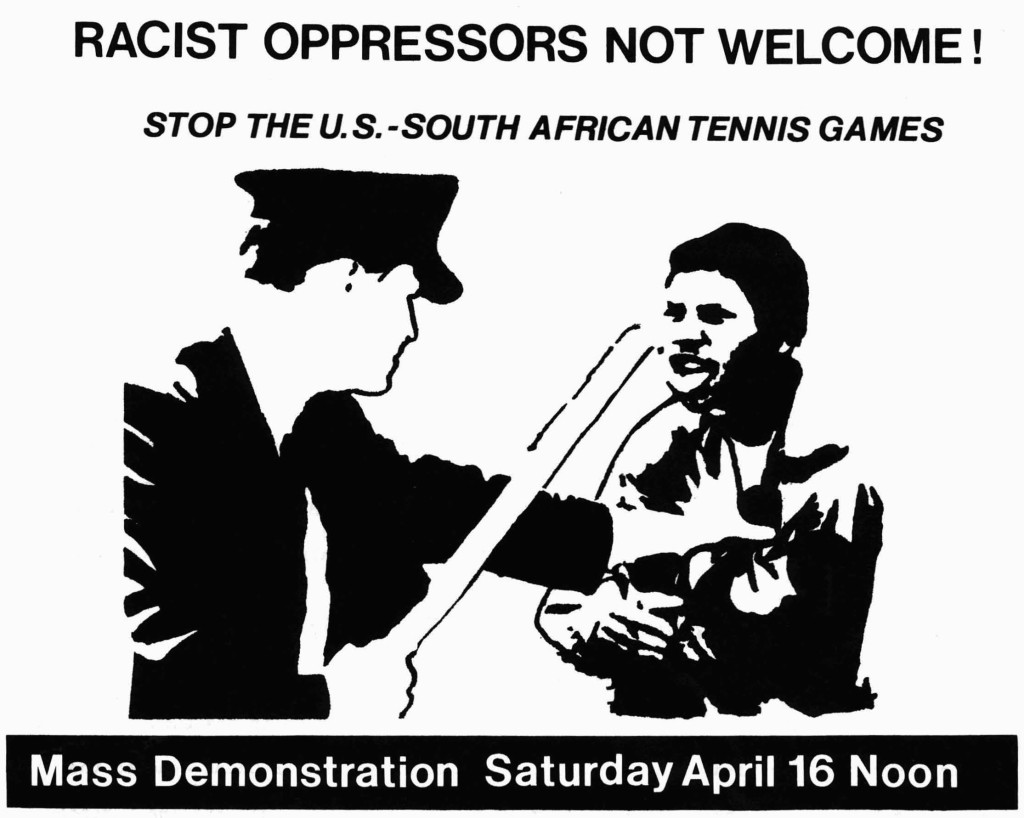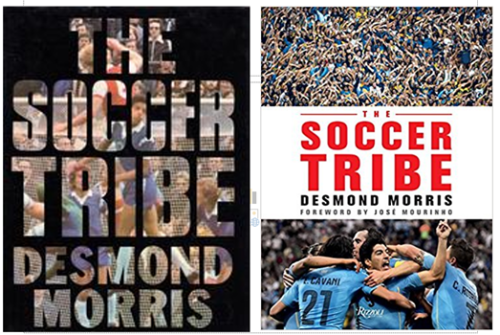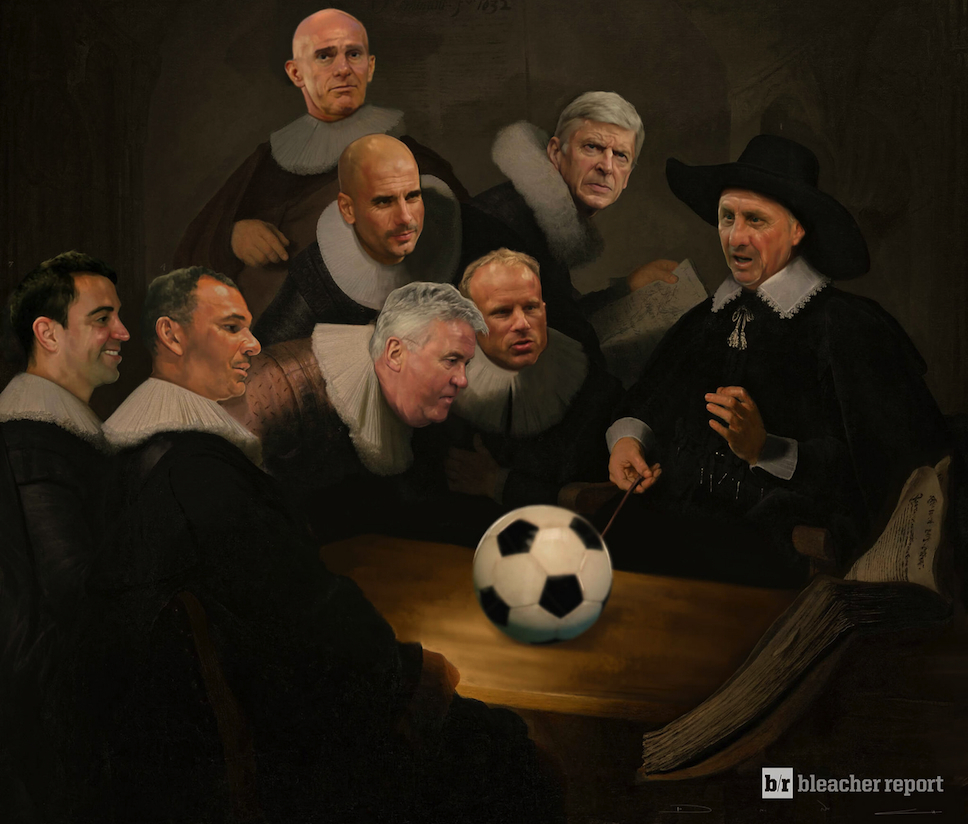
A couple of weeks ago, I was mired in grading final papers and exams when I received the first student emails about my “Global Soccer” online summer course.
“Professor,” an eager young man wrote, “I’m really excited about taking your soccer class and want to get an early start.” His enthusiasm, while obviously welcome, also raised my anxiety level. He had inadvertently reminded me that the time had come to complete the “drafty” syllabus and to quickly finish marking and submit my final grades.
A few double sessions later, the seven-week introductory course was ready to go. Using Michigan State’s D2L learning management system, students explore the relationship between soccer and social change.
A mix of academic and popular readings, lecture videos, and films take them swiftly across continents. We look at a number of topics and case studies, including: ancient ball games and the rise of association football; fan cultures and stadium disasters; the men’s and women’s game in the U.S.; soccer and politics in Brazil and Argentina; Africa’s role in globalizing the game; and the FIFA World Cup “in sun and shadow” (to borrow from Eduardo Galeano). Special attention is paid to how soccer relates to power, economic interests, and issues of race, ethnicity, class, gender, community, and nation.
When the course kicked off yesterday, enrollment had reached 150. A very healthy number! Thankfully, I have three excellent graduate assistants helping me manage the workload.
My soccer tribe (Desmond Morris docet) is made up of students drawn from 49 different majors. Business majors lead the pack (27% of the total), followed by advertising, kinesiology, human biology, geography, and chemical engineering. Smaller cohorts come from computer science, education, economics, accounting, journalism, electrical engineering, prenursing, psychology, dietetics, and packaging. Finally, there is an intriguingly long list of “lone wolves” from physics, linguistics, studio art, prelaw, neuroscience, horticulture, and more. In other words, our virtual classroom in many ways resembles a stadium crowd: a broadly representative snapshot of the larger community.
It probably doesn’t hurt enrollment that 2018 is a World Cup year and that I am teaching this course for a sixth consecutive year. Still, the overwhelming majority of students are taking it because they need the 4 General Education credits to satisfy university requirements. It helps to have an unconventional topic and the online format is also appealing. Students away from campus can continue making progress towards a degree while also working summer jobs, traveling, or simply filling time between marathons of Fortnite and FIFA 18 (the best-selling sports video game in the United States).
As an historian, I find it consistently invigorating to venture outside my disciplinary comfort zone and interact with different types of students. It’s an antidote to pedagogical predictability and stagnation and one of the main reasons why I genuinely enjoy teaching General Education classes. Even in summer!
Category: Fútbology
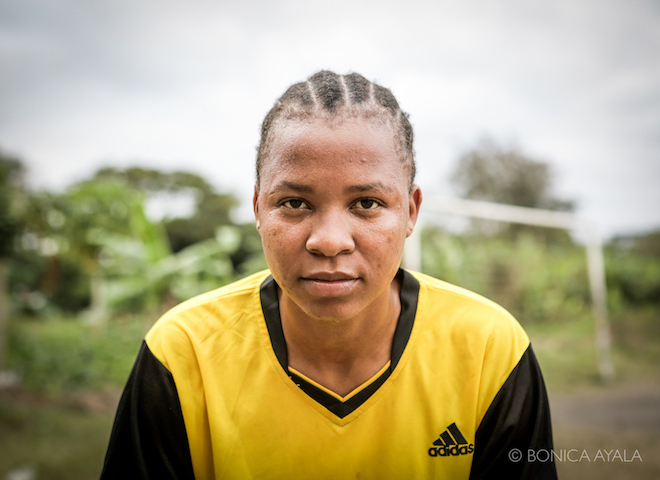
I recently went on a cinematic journey that took me from women’s soccer in Zanzibar to a failed stadium-and-entertainment complex in Buenos Aires.
My travel agency, so to speak, was the Football Scholars Forum. On February 23 it held an online discussion of two low-budget, high-return documentary films. (A recording of the event can be found here. Audio quality improves significantly around the 20 minute mark.)
“New Generation Queens” by Megan Shutzer tells the story of a Zanzibari women’s team. The documentary follows the compelling lives of younger and older women to cast light on the culture of the women’s game on the East African island, which is 99% Muslim. The 50-minute film alternates interviews with passionate players and determined organizers with footage of training sessions on rudimentary pitches. As an historian, I especially liked the remarkable 1988 footage of a Swedish team playing against a local team: the first official women’s game in Zanzibar! After the set up, the film’s main story line becomes the New Generation Queens’ journey to mainland Tanzania for a major tournament. Only the younger players participate in the Under-15 event, an important recruiting venue for the Tanzanian national side. Shaba “Messi” has a lot riding on this competition.
“Ciudad Deportiva—El Documental,” co-produced by Alex Galarza and four Argentine journalists, tells the story of Boca Juniors’ failed attempt in the 1960s and early 1970s to build a 150,000-seat stadium and recreational complex. The 45-minute documentary combines rich archival footage with still photography and interviews, to reconstruct the history of a monumental sports and urban development project. Focusing on Boca Juniors, one of the most popular clubs in the fútbol-mad city (cf. River Plate, Velez, San Lorenzo, among others), and their influential, albeit dodgy president, Alberto Armando, “Ciudad Deportiva” uncovers multiple and complex links between soccer, politics, and urban history in the mega-city of Buenos Aires.
The two enterprising film makers bring impressive academic credentials to their projects. Galarza has a PhD in Latin American History from Michigan State (where I had the distinct pleasure of serving on his doctoral committee), and is currently a Postdoctoral Fellow at Haverford College. Shutzer has a BA from Harvard, did graduate work at Stanford, is fluent in kiSwahili and works in development.
At the Football Scholars Forum, the pair explained the genealogy of their (first) films, narrative choices and production techniques, as well as approaches to film distribution. Notably, Galarza and Shutzer emphasized their commitment to collaborating closely with local people in the filmmaking process. Both spent years doing fieldwork in Buenos Aires and Zanzibar: nurturing relationships, listening to their interlocutors, building trust, and, of course, playing soccer.
The numerous differences between the films make them intriguingly complementary. “Ciudad” is a historical tale told in Spanish by men (though a female narrator) linked to one of the world’s most famous football clubs. “New Generation Queens” is a contemporary story that centers Swahili women’s voices and experiences located at the distant periphery of the global game.
I highly recommend both films. In a glut of English-language soccer media content, these documentaries stand out for their originality and production value. I also intend to use them in my classroom to challenge stereotypes about Muslim African women and to raise questions about the politics of stadium development, past and present.
The Promised Land of Leeds
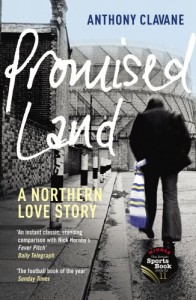 The Football Scholars Forum’s last session of 2017 took place on December 7.
The Football Scholars Forum’s last session of 2017 took place on December 7.
Author and journalist Anthony Clavane discussed his splendid book, Promised Land: A Northern Love Story, which won the 2011 UK Sports Book of the Year award.
Part memoir, part social history, part fútbology, Promised Land is as much about Leeds (the city) as it is about Leeds United (the club). In the publisher’s words: “This is a book about football. It’s about unconditional love for a club, even when it doesn’t always seem to love you back. But it is also a book about much more than that.”
The FSF discussion revolved around the themes of belonging, community, and identity. Football cannot be adequately understood, Clavane’s work shows, without thinking deeply about the social, economic, political, and cultural underpinnings of sport. Leeds and United lent themselves quite well to this kind of analysis, as they embodied broader transformations in English football and society.
Listen to an audio recording of the session here and read live tweets here.
The Football Scholars Forum’s next online gathering takes place on February 23, 2018 (2pm ET). It will explore documentary film as a medium for stories about soccer. For additional information and to participate, click here.
Nelson Mandela would have been proud of Colin Kaepernick and the black (as well as a few white) U.S. athletes involved in the national anthem demonstrations against police violence and systemic racism. “Sport has the power to change the world,” Mandela believed. “It has the power to inspire. It has the power to unite people in a way that little else does. It speaks to youth in a language they understand. Sport can create hope where once there was only despair.”
This weekend I am presenting a paper that puts some of these issues in historical perspective at the 14th North Eastern Workshop on Southern Africa.
Using a mix of primary and secondary sources, “Sport and Social Justice in South Africa: Historical Reflections” shows how soccer, rugby, cricket and other sports carved out spaces in which to contest white power and raise awareness among athletes, coaches, officials, and fans of the evils of racism. It explores how black (and some white) sportsmen and women, South African and not, over the course of the 20th century worked hard to connect sport to advocacy for equal rights, citizenship, and the reduction (or elimination) of unjust inequalities.
After the rise of apartheid in 1948, a number of sports activists overtly challenged segregation, mainly by launching a global boycott of white South African sport. Sports sanctions, beginning with a FIFA suspension in 1961 and continuing with expulsion from the Olympics in 1970 and eventually from nearly every major sport, propelled the Anti-Apartheid Movement and contributed to the struggle for national liberation.
In the final section, the paper grapples with the impact of the commercialization of sport in the 1980s and 1990s and its changing social and political role during the transition from apartheid to democracy. In doing so, it notes the increasing marginalization of social justice initiatives and discourses in sports. Since the end of the boycott in 1992, the lion’s share of the medals, money, glory, and career opportunities has gone to a few historically advantaged white men and some members of the new black upper-middle class.
For just about everyone else, the pride elicited by Olympic and world champions Caster Semenya and Wayde Van Niekerk sits alongside sport’s fading willingness to meaningfully address inequality and injustice in the age of Jacob Zuma, Marikana, and #FeesMustFall.
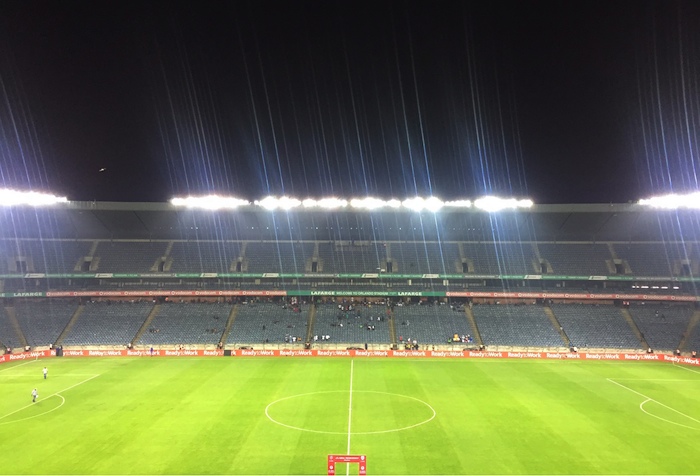
The welfare of South African football used to matter beyond its borders.
In 1974, for example, the Brazilian João Havelange won the FIFA presidency in a fiercely contested election against the conservative English incumbent, Sir Stanley Rous. He canvassed for votes in Africa, Asia and the Americas, sometimes with Pelé in tow. The businessman and former Olympic swimmer promised marginalized FIFA constituencies additional berths in the World Cup finals and greater funding for soccer development programs. Havelange also sided with African activists and the global Anti-Apartheid Movement to keep South Africa out of FIFA. Africa’s delegates reciprocated with their votes and the Brazilian supremo went on to transform FIFA into a massive global business, which he ruled with an iron fist for the next quarter century.
Since readmission to FIFA in 1992, South Africa has won two continental titles at club level and one at senior national team level. Its Premier Soccer League, according to World Soccer magazine, ranks 25th in the world (alongside Scotland). The women’s game has also grown, though significant challenges remain. The country’s successful hosting of the 2010 World Cup symbolized the great advances in South African football, particularly its organizational sophistication and financial resources.
Despite such undeniable progress, local football hardly resonates internationally anymore. In fact, many South African fans and pundits are disillusioned about the state of the domestic game.
Like almost everyone else in the early 1990s, my peers and I were fascinated by the exciting new times ushered in by the demise of apartheid. We were scrawny young boys who, like kids anywhere, lived for the game. We believed readmission into world football ignited the possibility of a future professional playing career. Things worked out differently for us.
On a recent visit to the Lebanon neighborhood of Mabopane, the township of my teenage years, it was disheartening to see how the game was no longer a central part of social life in the community in which I grew up. The dusty fields where we contested many epic duels are covered with shrubs. Those pitches that are still in playable condition are occupied by charismatic churches, which are flourishing in many poor African communities by selling salvation to people in hardship.
Grassroots football, at its best, can serve as a bulwark for a wide range of social ills that thrive where recreational resources, human and material, are scant. Any community with “redundant youth” who have lots of free time is a recipe for disaster. No wonder Mabopane and other townships on the outskirts of Pretoria are at the epicentre of the nyaope street drug epidemic ravaging South Africa today.
The grassroots game has more players and coaches than the formal game administered by the South African Football Association. Even though informal football is neither expensive to play nor to administer, it receives minimal financial investment and is wracked by insecurity and instability. This is why residents of Mabopane, like thousands of fútbol-loving South Africans, take it upon themselves to ensure the vitality of the grassroots game.
Blaming the administrators and corporate sponsors entrusted with the game’s welfare is understandable, but communities can ill-afford to delegate responsibility for social health to people and structures who do not genuinely have their interests at heart. The July 29 tragedy at FNB Stadium, which killed two fans and injured more than a dozen people in a gate crush at the Kaizer Chiefs-Orlando Pirates derby, is a case in point.
The tragedy showed how South African soccer’s leadership struggles with ensuring spectator safety at big matches while continuing to do very little for the development of the sport at the bottom of the the pyramid. Until these fundamental issues are resolved, black families will continue to worry every time their loved ones go to a football match, whether at the neighborhood sandlot or at a World Cup stadium.
Pan-African Sports Studies
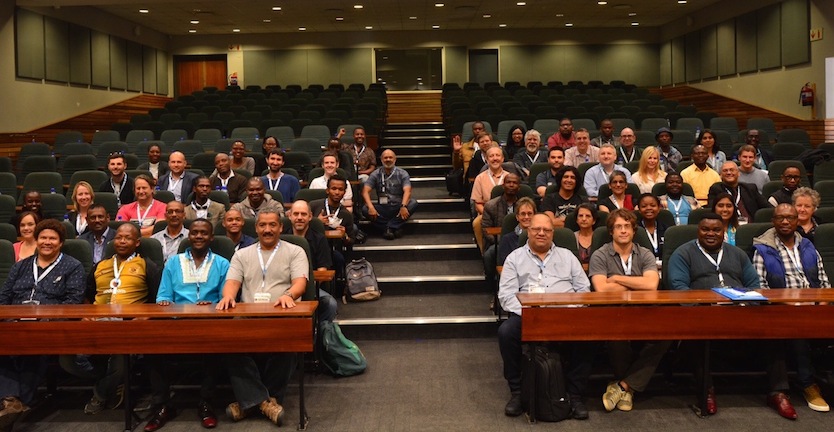
The University of Zambia will host the 12th Sports Africa conference on March 26-28, 2018. The theme of the conference is: “Pan-African Sports Studies: Beyond Physical Education.”
The conference in Lusaka will bring together sports scholars and practitioners from African, North American, and European Universities working on a diversity of topics in a wide range of disciplines.
The event builds on the April 2017 conference hosted by The Institute of Reconciliation and Social Justice at the University of the Free State in South Africa. I joined scholars from around the continent and the world for three days of presentations, workshops, and discussions in Bloemfontein around the theme of “Sporting Subalternities and Social Justice” (see photo above). In my keynote address, “Black Sport Matters: A History of Sporting Subalterns’ Quest for Social Justice in Africa,” I told stories about African athletes, administrators, and fans who used their visibility and influence to make powerful claims for equal rights and to advance a variety of social justice causes. Ranging from the colonial era to the contemporary period, I looked at the factors that motivated African sports activism, strategies and tactics, successes and failures, and connected this history with struggles against racism, sexism, and homophobia waged by black athletes today.
At next year’s conference I may present a co-authored paper with Liz Timbs, which examines aspects of youth sports development in South Africa through a history of the Izichwe Youth Football Academy in Pietermaritzburg, KwaZulu-Natal. More on this project as things develop, of course.
For more information about the 2018 Lusaka conference visit: http://sportinafrica.org/conference2018/
This post was originally published on Andrew Guest’s Sports and Ideas Tumbler page. It is cross-posted here with permission of the author.
I recently stumbled across a new (2016) edition of The Soccer Tribe by Desmond Morris, the peculiar tome originally published in 1981 with a mix of text and illustrations making a case for what amounts to an evolutionary socio-biology of soccer. Morris, most famous for The Naked Ape, explains that he was motivated by anthropological curiosity: “Hardly anyone seems to query the importance attached to the game. For those who do the kicking and those who watch it so avidly, the whole matter is taken for granted. Football is football, and of course it is fascinating, so what is there to question? For those who ignore it, it is plainly a stupid waste of time, so why bother with it? It is not worth discussing. Both sides overlook the fact that, viewed objectively, it is one of the strangest patterns of human behaviour to be seen in the whole of modern society.”
In seven sections and 44 chapters full of pictures, illustrations, and quirky charts, Morris then lays out an analysis of soccer in its ‘tribal’ dimensions: roots, rituals, heroes, trappings, elders, followers, and tongue. The whole thing is amazingly odd; in its scope, it compares to nothing else I’ve seen or read about soccer. In analyzing uniforms as tribal costumes, referees as tribal judges, or fan songs as tribal chants the book exhibits an imagination and ambition that I love (and have cited before here).
But since initially stumbling upon the first 1981 edition a decade ago something has always felt just a bit off about the book. It took this new edition, which seems to have been updated mostly in its illustrations (along with a few minor segments of text), to make me dig into that feeling.
The couple hundred words José Mourinho ‘wrote’ as a foreword to the new edition sets the tone: ““Total football has led to global football—on and off the field. And whoever fails to realize it doesn’t understand anything. Those who only know football know nothing about football.”
This blustering certainty is familiar from Mourinho, but it is also fundamental to the underlying premise of The Soccer Tribe – that all the patterns and rituals of modern soccer, and modern society, are a direct inheritance from humanity’s hunter-gatherer past. If Mourinho would have gone the academic route, I realized, he would have been a socio-biologist.
To be fair, Mourinho goes onto say something more interesting: “Those who only see twenty-two men chasing after a ball fail to understand its geometry, its ballet, its psychological depth, its true nature. It is the most faithful representation of human nature and its may faces. It is a tribe where the rationale of tactics, emotion, and the fun of the game all prevail.”
Though still a bit grandiose (and not overly convincing as to the question of whether Mourinho actually read the book), the basic idea of their being more to the see than ‘chasing after a ball’ is the real value of The Soccer Tribe.
The problem, however, was well articulated back in a 1983 review of the original book by Ian Taylor in the journal Theory, Culture, & Society.
What is it that is objectionable and in need of challenge in this account of association football? It is not, as we might at first think, an empirical matter (much of what is said about the origins, the present form of the game and its surrounding rituals is quite accurate and consistent with other well-respected accounts). But there are empirical silences. In the familiar fashion of most sociobiology, there is a great emphasis on football as a (naturally-evolving) form of male-bonding and, indeed, of male “warriors” (who proceed, we are told, to create homes for the “warrior mates” that are peaceful retreats from the violence and stress of the field of play”) (p 181). The account is therefore silent on the considerable growth of women’s participation in the playing of soccer In recent years, especially in North America. Again, the celebratory discussion of soccer’s present status as a world sport is couched as if some other universal and natural logic is at work. This reads very oddly in 1982, not only for the British, German and other soccer lovers worried for the future of the sport in the light of the massive reductions in attendances, but also for students of sport who have noticed the spectacular growth of a genuine plurality of spectator and participant sports in most developed countries.
The Soccer Tribe and socio-biology, in other words, present a totalizing account of human behavior that ignores the dynamism of culture. Women’s soccer is a key counter-example. If soccer is a male warrior ritual to satisfy our hunting and fighting brain modules, what to make of women’s soccer and women fans? Taylor phrases it nicely (if academically): “The empirical display of soccer as a natural form, spanning all cultures and time, masks the specificity of the game’s significance in particular social formations.”
The game itself, in the phrasing I tend to prefer, is mostly just an empty cultural form.
And, speaking of empty, the other substantive review of the original 1981 Soccer Tribe book that I could find was by the novelist Martin Amis for the London Review of Books. Amis, after a strange and extended prattling on about the English national team’s performance in qualifiers for the 1986 World Cup, dismisses Morris in two withering paragraphs, starting by noting that a soccer manager left alone with the book might “die of inanition”:
“In The Soccer Tribe Morris maps out the connection between ‘ancient blood sports’ and ‘the modern ball game’. Nowadays, the goalmouth is ‘the prey’, the ball ‘the weapon’, and the attempt to score ‘a ritual aim at a pseudo-prey’. Is this true? Or, more important, is this interesting? Morris goes on to say that ‘in England, there are four “divisions”, presenting a parody of the social class system.’ He then traces the analogies between football and religion: ‘Star players are “worshipped” by their adoring fans and looked upon as “young gods”.’ Later on, he develops a far more compelling thesis, arguing that . . .
Ah, but the sands of space are running out. That’s enough football for today. I only have time to add that Morris’s book is handsomely packaged, that the pictures are great, magic, brill etc, and that the text is an austere, an unfaltering distillation of the obvious and the obviously false.”
Amis’s point, beyond being arrogant and dismissive, seems to be that it is hard to be an intellectual interested in football—and Morris fails unreservedly.
But I think that is too harsh. The Soccer Tribe is like much socio-biology (and contemporary evolutionary psychology): simultaneously problematically reductionist and thought-provoking in a challenging way. I find it interesting, for example, that The Soccer Tribe shows up as ‘cited by’ 250 academic works in Google Scholar – though a crude marker, it is clear from browsing those citing works that the book inspired some academics to new ways to think about the game.
But it doesn’t yet seem to have inspired another similar effort–I’ve yet to see another book that takes on the totality of soccer culture in an intentional way. The 2016 ‘new edition’ ofThe Soccer Tribe thus doesn’t need much updating beyond the pictures both because the analysis freezes culture as permanently set by evolution, and because not enough of significance has come out since 1981 to offer a more dynamic theory of the game as a whole. That may no longer be the way of academic work on soccer – which has indeed done much to chip away at understanding pieces of the game – but it sure would be fun to see.
